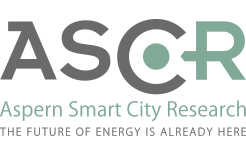Smart information and communications technology (ICT) plays a key role in driving climate protection and intelligent urban development. It ensures that all stakeholders in the energy system (smart buildings, smart grids, smart users) have the right data and information at the right time to make the right “decisions” on energy generation, consumption, storage and even trading.
Within the framework of ASCR’s research, intelligent technology is used to link up all the data obtained from the buildings and the grid, such as temperature, indoor air quality, power consumption or voltage, with external data such as weather or energy use. These data are processed in compliance with strict data protection guidelines. The technology allows the interplay and reciprocal effects between the grid, the buildings and users’ energy consumption to be automatically analysed and optimally controlled.
Self-learning systems
Building use and network capacity utilisation are subject to constant change, necessitating continual readjustment of the simulation models. Adaptive self-learning algorithms are used to refine the models and subsequently the internal building and network control mechanisms.
The information obtained in this way is particularly important for optimum integration of renewable energy. ASCR is exploring the effects of using different energy sources – in different combinations and under changing weather conditions – on the grid and on buildings. It is possible to predict potential local overloads or resolve bottlenecks by improving coordination between the grid and the building.
Digital reality thanks to big data
Around 1.5 million measured values are collected in the ASCR testbeds every single day. To cope with the enormous amounts of data from the various domains, research in the smart ICT domain uses big-data analysis methods. One aspect of this research is to find out how much data is actually needed for what period of time. After all, the more data has to be stored and processed, the higher the costs! The collected data can then be digitally reproduced and upscaled, making it possible to optimise internal consumption and power distribution and to detect potential problems in the network, such as voltage fluctuations, early on. This allows extensions, various scenarios, energy concepts and optimisation measures to be simulated on a new, previously unknown scale – all on the basis of real consumption data. These achievements all contribute to the long-term goal of ASCR: to develop efficient urban energy solutions that can be applied to entire cities.
Use Cases
Interim results in smart ICT research
Different data collection intervals were initially tested to ensure the quality of the data. The data provided by the building was evaluated using specially designed algorithms, which were also used to identify interdependencies.
We have succeeded in optimising the investment and operating costs of the ICT landscape by testing different data resolutions to find out how much data is really needed for what period of time.
The ICT testbed at aspern Seestadt also provided valid empirical data for the smart meter rollout, which commenced in 2018.
Applications and services
The integration and exchange of data from different sources are the basis for the development of key applications and services for the various stakeholders. The system supports reporting, simulation and comparative analysis of buildings and parts of buildings and the grid to evaluate optimisation measures in both operation and equipment.
In operational grid planning, newly developed applications support the detection of anomalies and threshold breaches in the low voltage grid. In addition, digital modelling can be used to simulate suitable measures.
Load forecasts can be generated on the basis of historical information and external factors such as weather or events (public holidays, for example) using intelligent machine learning technology. Residents can use home automation to operate the controls themselves, thereby saving energy and enhancing their personal comfort.
